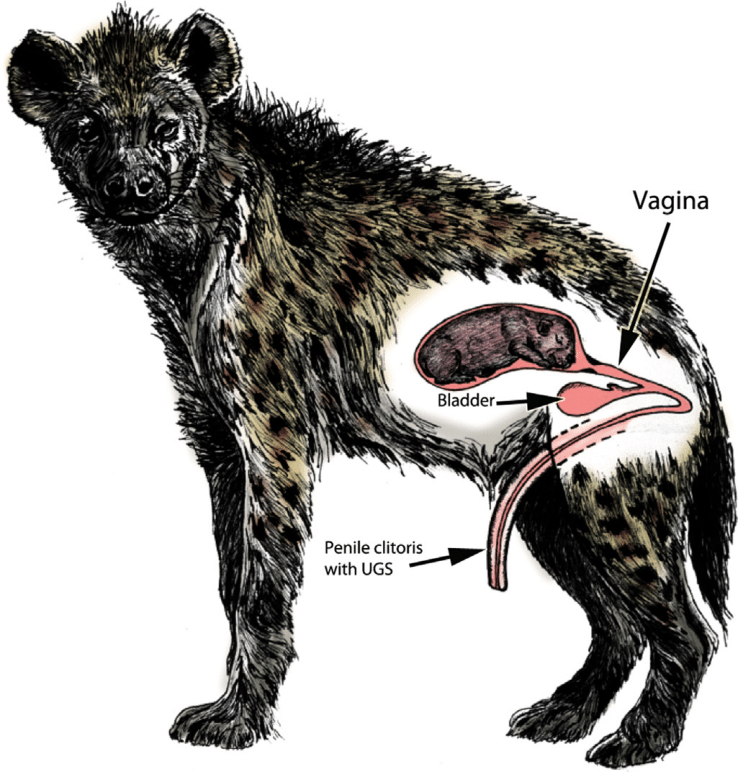Nature is full of fascinating and sometimes brutal adaptations, but few are as shocking as the birthing process of the spotted hyena. You might think childbirth is a universally painful experience, but hyenas take it to an entirely new level.
Female hyenas have one of the most unusual reproductive anatomies in the animal kingdom—what appears to be a penis is actually an elongated clitoris, known as a pseudo-penis. This rare adaptation makes mating, birth, and survival incredibly difficult for both mother and cubs.
Let’s dive into the science, struggles, and evolutionary mysteries behind why hyenas experience one of the most challenging births in the wild.
Hyenas’ Unique Reproductive Anatomy: A Bizarre Evolutionary Twist

The female spotted hyena (Crocuta crocuta) is unlike any other mammal when it comes to reproduction. Unlike most female mammals, hyenas have no external vaginal opening. Instead, their labia are fused together, forming a pseudo-scrotum, and their clitoris is elongated into what resembles a fully functional penis.
This means that both mating and giving birth happen through a narrow, tough, and inflexible canal—a structure that poses serious risks to both mother and cubs.
But why would evolution favor such an extreme adaptation? The answer lies in hyena social structure and dominance.
The Link Between Dominance and Reproductive Anatomy
Hyenas live in strict matriarchal societies, where females outrank males in dominance. The unusual reproductive anatomy is believed to be an evolutionary adaptation linked to social hierarchy.
- A Display of Strength: A larger pseudo-penis might act as a dominance signal, making it clear which females hold power in the clan.
- Hormonal Influence: Female hyenas have higher testosterone levels than males, leading to increased aggression and dominance over the pack.
- Mating Challenges: Males must earn the right to mate, as females control copulation with their complicated anatomy.
Video : Hyenas’ Brutal Birth: The Most Painful Labor in the Animal Kingdom
While this system gives females power, it comes at a terrible cost when it’s time to give birth.
Why Giving Birth Is So Dangerous for Hyenas
Imagine trying to push a newborn through a passage too small, too rigid, and highly prone to tearing. That’s exactly what female hyenas go through every time they give birth.
Here’s what makes hyena birth so deadly:
- A Super Tight Birth Canal
- The pseudo-penis acts as the only birth canal, but it is long, narrow, and lacks the elasticity of a normal vagina.
- This makes labor extremely difficult and painful, with a high chance of the tissue tearing.
- First-Time Mothers Face the Worst Risks
- Many first-time mothers do not survive the birthing process due to severe ruptures.
- Those who do survive often suffer from long-term damage to their reproductive organs.
- High Cub Mortality Rate
- A staggering 60% of hyena cubs suffocate before they are fully delivered.
- Since the birth canal is so tight, cubs often become trapped and die before they can emerge.
- A Painful Recovery Process
- After birth, the pseudo-penis often ruptures completely, forcing it to heal over time.
- Mothers suffer weeks of pain and vulnerability while their bodies recover.
Despite these brutal challenges, hyenas continue to thrive, and their unique reproductive system has remained largely unchanged for millions of years.
How Do Hyenas Mate? The Struggles of Reproduction

If you think birth is difficult for hyenas, mating is no easier. Males must overcome significant anatomical and social obstacles just to reproduce.
- Males Are Submissive to Females
- Unlike in many species where males dominate, male hyenas are the weaker sex in both power and ranking.
- They must approach females cautiously, often displaying submissive behavior to gain approval.
- Navigating the Pseudo-Penis
- Since females have no traditional vaginal opening, males must carefully maneuver through the pseudo-penis to copulate successfully.
- This requires both patience and precise positioning, making it one of the most complex mating processes in the animal world.
- Only the Strongest Males Get to Reproduce
- Males don’t fight each other for dominance like in other species. Instead, they must earn the female’s trust over time.
- Females choose mates based on persistence, patience, and respect, ensuring only the most determined males pass on their genes.

Given how dangerous and inefficient the reproductive process is for hyenas, one might wonder why evolution hasn’t corrected this issue.
The answer lies in survival strategy and social dynamics.
- Matriarchal Control Guarantees Stronger Cubs
- By limiting mating to only the most persistent males, female hyenas ensure that their cubs inherit strong genetics.
- This method prevents weaker genes from spreading, keeping the species robust.
- Higher Testosterone Helps With Survival
- The same high testosterone that makes birth difficult also makes female hyenas stronger and more aggressive.
- This aggression helps protect their cubs and maintain dominance in their environment.
- Fewer Cubs = More Resources
- Since many cubs don’t survive birth, the ones that do are often given more attention and resources.
- This ensures the strongest cubs make it to adulthood, increasing the clan’s overall survival rate.
The Resilience of the Spotted Hyena
Despite their brutal birthing process, hyenas have thrived for millions of years. Their ability to adapt, dominate, and survive proves just how powerful evolutionary trade-offs can be.
- They are among Africa’s most successful predators, competing with lions for food.
- Their clans are ruled by powerful females, ensuring only the strongest members survive.
- They have some of the most advanced social structures in the animal kingdom, making them highly intelligent and strategic.
Video : The Most Extreme Births In The Animal Kingdom
Conclusion: Nature’s Ultimate Test of Survival
Hyenas are proof that nature often prioritizes survival over comfort. Their unique reproductive anatomy, extreme birthing challenges, and dominance-driven society have allowed them to thrive despite overwhelming odds.
While their birth process remains one of the most painful and deadly in the animal kingdom, it also ensures that only the strongest females and cubs survive.
So the next time you see a spotted hyena, remember—they’re not just fierce scavengers. They’re survivors of one of evolution’s toughest reproductive challenges.
Here’s when Kate Middleton is going to appear
The question of what is going on behind closed doors at Windsor is one of the most asked questions during the last couple of months, or better said since Kate Middleton‘s last public appearance.
The Princess of Wales had undergone a “planned” abdominal surgery in mid-January and ever since, her exact health state or whereabouts haven’t been discussed by the Palace except for the statement which came as a for of reassurance that she was “doing well,” and that they won’t be sharing any details except when they feel something truly significant takes place.
The people of Britain, as well as those from around the world who closely follow the situation involving Kate and the rumors surrounding her state, were given a glimpse of hope when the Minister of Defense confirmed that she would be attending the Trooping the Colour dress rehearsal ceremony on June 8, ahead of the main event on June 15.

However, it later turned out that it was a mistake and that Kate’s potential return to royal duty event has been deleted from an Army website. As per GB News, Kensington Palace was “not consulted” regarding the Princess of Wales’ appearance.
“It seems the MoD jumped the gun with this announcement and that Kensington Palace was not consulted…we will have to wait to see if the PoW will be well enough to attend,” Telegraph royal reporter Victoria Ward posted on X.
What’s most, the event’s overview mentioned Kate’s presence multiple times.
“Trooping the Colour reviewed by Her Royal Highness The Princess of Wales is identical to Trooping the Colour reviewed by His Majesty The King,” “Trooping the Colour reviewed by Her Royal Highness The Princess of Wales also includes 250 soldiers from the Foot Guards,” and “The soldiers will be inspected by Her Royal Highness The Princess of Wales, Colonel Irish Guards.”
The site removed every information related to Kate and the event as well as her photo on the site’s landing page.

Kate hasn’t been seen in public for a long period of time, which is very unusual for a royal of her rank.
The public could last see her on a photo taken by TMZ, which some claimed was staged.
She also posted a photo herself on Mother’s Day on which she could be seen together with her children, but it was later determined the photo had been edited at parts which led to the news agencies to issue “kill notices,” which are advisory notices to remove or not use a specific photo.
“It appears that the source has manipulated the image,” the Associated Press notification read.
They also released a statement, saying, “The Associated Press initially published the photo, which was issued by Kensington Palace. The AP later retracted the image because at closer inspection, it appears that the source had manipulated the image in a way that did not meet AP’s photo standards. The photo shows an inconsistency in the alignment of Princess Charlotte’s left hand.

Although the Palace didn’t comment on the edited photo, Kate herself decided to explain why the image had “flaws.”
On her and William’s official X account, she wrote, “Like many amateur photographers, I do occasionally experiment with editing. I wanted to express my apologies for any confusion the family photograph we shared yesterday caused. I hope everyone celebrating had a very happy Mother’s Day. C.”
Kensington Palace has later confirmed it “would not be reissuing the original unedited photograph of Kate and her children.”
Please SHARE this article with your family and friends on Facebook.



Leave a Reply